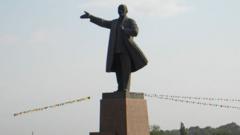Kyrgyzstan has recently dismantled a large statue of Vladimir Lenin, once considered the tallest in Central Asia. The statue, which stood 23 meters tall in the city of Osh for over 50 years, was removed earlier this week, with images circulating online showing it lying on the ground after being lowered by a crane. The statue, a symbol of the Soviet era, had remained a feature of the landscape since the nation was part of the Soviet Union.
As several former Soviet republics undergo cultural shifts, this removal aligns with their efforts to reshape national identities and reduce the prominence of Soviet-era symbols. However, local officials chose to downplay the significance of the removal, emphasizing the logistical reasoning behind it.
A statement from Osh City Hall cited the need to enhance the "architectural and aesthetic appearance" of the city as the primary motive for relocating the statue. City officials referenced similar actions taken in Russia, where Lenin statues have been removed, positioning the move within a framework of common urban development practices. Moreover, the space previously occupied by the statue is set to be replaced with a flagpole, following a similar pattern seen in Bishkek, the capital of Kyrgyzstan.
It’s notable that the decision comes just after Russia inaugurated a new statue of Josef Stalin in Moscow, prompting a sense of caution among Kyrgyz authorities regarding national sentiments toward their powerful neighbor. Having gained independence 34 years ago during the Soviet Union's collapse, Kyrgyzstan still carries remnants of its tumultuous past, with elements like the second-highest mountain in the country, named Lenin Peak, serving as enduring reminders of Soviet influence.





















